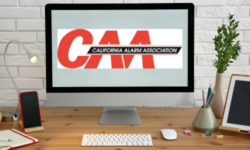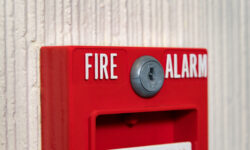University Fire System Takes the Heat
The recent number of fatal fires on college campuses across the United States has been disturbing news to parents, school administrators, fire officials and the public. Fortunately, such tragedy was averted at the University of Rio Grande in Ohio. When a blaze ignited in one of the school’s dormitories, all 72 students inside were safely evacuated.
Within 30 seconds, the Rio Grande and Gallipolis volunteer fire departments had been notified and responded immediately. They were able to control the fire quickly because the analog addressable fire alarm system installed by Security Technologies of Ashtabula, Ohio, pinpointed the exact location of the blaze, sounded alarms throughout the area and forwarded a signal to the company’s central monitoring station.
Upon visiting the site, firefighters saw melted smoke detectors hanging by burnt cable, horn strobes virtually dripped down the wall with the power wires melted together in a ball of plastic. Yet the remaining system was still performing its alerting functions, even after the fire was under control and until campus personnel powered down the system.
Although the dormitory sustained major smoke and water damage estimated at more than $500,000, it could have been much worse.
Forensic Findings Lead to New Fire System
Before the installation of the current fire alarm system, the university had experienced problems with its previous systems following a major storm and, as a result, filed an insurance claim. Forensic alarm expert, Jeffrey Zwirn, CPP, of IDS Research & Development Inc. of Teaneck, N.J., was retained by the insurance company to investigate this matter and performed a comprehensive on-site inspection and evaluation of the systems.
A review by IDS revealed serious defects and irregularities in the work that was alleged to have been performed by the previous alarm company. These improper actions concealed the dangerous and nonfunctional condition of the fire alarm systems that were intended to protect the students. At this point, the consulting firm immediately recommended that, for life safety reasons, the systems should be put on fire watch. At that time, Security Technologies was brought in for corrective action.
Dealer Introduces the Analog Addressable Concept to University
Having relied on conventional fire alarm equipment, the university was unfamiliar with analog addressable systems. Meanwhile, the old system was not being monitored by a central station. Both Security Technologies and IDS questioned the capability of this arrangement to furnish an adequate response time in the event of a fire.
The recommended analog addressable system would completely eliminate the need to investigate every room. In the event of an alarm, the system would pinpoint the exact detector and forward an immediate signal to the central station monitoring station. This proved to be a major factor in Security Technologies being awarded the contract.
The installation contract was signed for five of the university’s dormitories. Four of these dorms are older buildings constructed in the early 1950s while the fifth dormitory was built in the late 1970s. All are multistory buildings—in most cases three or four stories.
Because of difficulties experienced by the other alarm company, Security Technologies offered a special clause stating that final payment would not be required until the university was 100-percent satisfied with the installation.
Defining Audible Levels During Planning Phase
When it came time for planning the system, Security Technologies first evaluated all five dormitories to design the appropriate system for each building, and prepared four sets of drawings.
In designing and installing the fire alarm systems, Security Technologies had to address a number of major obstacles, including how to promptly detect a fire and pinpoint its location, while minimizing false alarms that could originate with student smoking, etc. Another obstacle was providing the audibility levels required by the National Fire Protection Association (NFPA) [a minimum of 70dBs level and 15dBs over ambient at pillow].
This proved to be a major task because of differing conditions in each dorm. Some dormitories have plaster ceilings and linoleum floors, and Security Technologies had to consider the echo effect on audibility levels. Other dorms have acoustical tiles and carpeting, which have a tendency to absorb some of the sound.
Chosen Equipment Mix Can Help Test Itself
For the core of the system, Security Technologies selected a microprocessor-based fire control panel that supports 127 analog/addressable devices and constantly performs testing and adjustments. The company also installed an analog addressable, photoelectric smoke detector for all the sleeping areas, gathering rooms, hallways and stairwells of the five dormitories.
For the boiler and furnace rooms, an analog addressable heat sensor was installed for use in hot, steamy areas, and features simple addressing. A pull station and mini input module were placed at each stairwell and other required areas.
A remote fire annunciator with an 80-character backlit display keypad was placed at the fire department entrance door. At this location, Security Technologies placed a detailed CAD drawing, which outlines each floor plan, the point ID and the placement of all fire alarm equipment. It is covered by Lexan to assure longevity and deter vandalism; it also speeds the response of fire department personnel, who may not be familiar with the layout of each dorm.
A fire alarm horn strobe was installed in all hallways, gathering rooms and restroom facilities throughout the dorms. This particular horn strobe device was chosen because it meets field-selectable volume adjustments and requirements for high intensity with acceptable current draw.
Each of the five fire alarm systems is equipped with a full activity printer and viewing software. University officials like the idea that each fire alarm control panel is equipped with an activity printer connected to an uninterruptible power supply (UPS).
Modern Dorm Presents Some Additional Challenges
The New Hall dormitory—the newest of the five dorms—was the most challenging to install the equipment. As one of the most modern buildings on campus, this dorm has a sprinkler system, fire pump and elevator recall. And, of course, interconnected with this system are the flow and tamper.
In the design for this particular installation, Security Technologies tied into the existing fire pump for trouble and alarm signals. With activation of the fire pump or conditions such as failure to start, overcrank or high temperature/low temperature, trouble signals will be generated and forwarded to the fire alarm system. Input modules were used for the interconnection between the fire pump and the fire alarm system. They were also selected to connect sprinkler and flow switches to the alarm system. An addressable relay module was chosen for elevator recall functions.
The major challenge of the installation was the amount of equipment involved. Additional conduit had to be installed in each of the dorms for handling all the equipment required to bring each system up to code.
Final System Testing, Training Goes Smoothly
Installation of the five analog addressable fire alarm systems took approximately 14 weeks. It began while students were living in the building during spring semester and continued into summer. A 24-hour fire watch was instituted in all dormitories. Hired by the university, fire watch personnel walked the halls, keeping constant alert to any potential fire. The entire installation cost the university approximately $180,000.
Security Technologies did a complete evaluation of each system after installation. This included testing every component and verifying all signals to the central station, as well as functionality testing of the complete system. This was followed by the required state certification inspection conducted by the state fire marshall’s office, a university representative and both DeGeorge and Dale Wisynai, Security Technologies’ field supervisor.
Within four to five months of the installation, the university completed several renovation projects throughout the dorms. Security Technologies returned to the campus to clean and test the system, enhancing overall effectiveness and preventing future false alarms.
Larry DeGeorge is president of Security Technologies of Ashtabula, Ohio. The company provides security, fire and video surveillance systems.
If you enjoyed this article and want to receive more valuable industry content like this, click here to sign up for our FREE digital newsletters!

Security Is Our Business, Too
For professionals who recommend, buy and install all types of electronic security equipment, a free subscription to Commercial Integrator + Security Sales & Integration is like having a consultant on call. You’ll find an ideal balance of technology and business coverage, with installation tips and techniques for products and updates on how to add to your bottom line.
A FREE subscription to the top resource for security and integration industry will prove to be invaluable.







